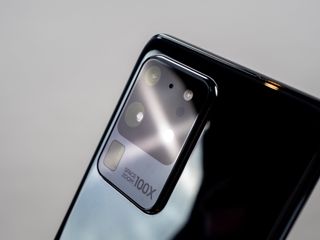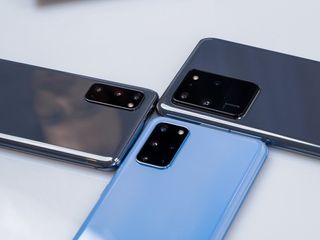With the Galaxy S20 Ultra, Samsung is finally taking phone cameras seriously

By now you've seen the spec sheets and may be poring over the details each Galaxy S20 model and how they may fit into your life. We've almost certainly reached peak smartphone, but it took until 2020 for Samsung to start taking phone photography really seriously.
That may sound a bit shocking given that Samsung has always put high-quality sensors in its phones, and has consistently offered the latest features — live photos, 4K60, super steady optical image stabilization — as the hardware makes them available, but in recent years the company has been trounced, lapped by three competitions that have approached photo and video capture in very different ways.
Whereas Google has kept it simple with its Pixel phones, opting to ship with turnkey and relatively small sensors that it can tune to perfection so everything can be done in post, Huawei has taken a different approach over the last couple of years, putting multiple massive sensors in its flagships while augmenting them with machine learning-based optimizations. Apple has found a balance in the iPhone 11 series, pushing larger pixels in its main and telephoto sensors while leaning heavily on on-device post-processing to eke as much fidelity from every photo as possible.

It's a tossup as to which phones take better photos — we've even tried to rank them and it's pretty damn hard, though I'd opt for the Pixel 4's images the majority of the time — but what became clear through all of their iteration was a pulling away from Samsung in the quality department.
Samsung realized the hard way that it if its processing isn't great, it needs bigger sensors to make up the difference.
Now, I'll say it upfront that Samsung still owns Android video, but in terms of photo quality, the actual photo hardware found in phones from 2016's Galaxy S7 through 2019's Galaxy S10 didn't change all that much. Which meant the Samsung was being forced to put an increasingly heavy load on tweaking photos after each photo was taken, and that just hasn't scaled well for the company. Photos taken in anything less than perfect light tend to come out soft or grainy or muted or a combination of all three.
The company hit the limits of what was possible with small camera sensors, and its dual-aperture gimmick it introduced with the Galaxy S9 just didn't have the intended effect of improving low-light shots. Even the Galaxy S10's post-introduction night mode, an addition made in direct response to criticisms to the phone's low-light output next to Google's near-magic Night Sight, failed miserably.
Which leads us to the Galaxy S20. As you'll read in our hands on, all three models have larger primary sensors, but it's the Galaxy S20 Ultra that shows the most promise. Like Huawei's P30 and Mate 30 Pro, Samsung's 108MP sensor in the Ultra is comparatively massive — three times larger than the one found in the Galaxy S10. Its 1/1.33" size is just about the largest one we've seen in a smartphone.
Be an expert in 5 minutes
Get the latest news from Android Central, your trusted companion in the world of Android

That change alone should be enough to considerably improve detail and, in low-light situations, keep the phone from ramping up sensitivity and introducing grain. But the larger sensor also contains 108 million pixels, which is nine times the number found in the Galaxy S10's primary sensor. The idea here is to use pixel binning to combine nine pixels into one, ending up with a 12MP photo that's ostensibly much, much clearer.
Samsung can then apply any and all of the machine learning-based post-production tweaks that it was doing on the S10 — presumably improved, because of time and experience and a host of hardware-based improvements to the Spectra ISP and Hexagon DSP found in the Snapdragon 865 — but this time it's coming from a much cleaner source.

The Galaxy S20 Ultra is too expensive for most people, but you can rest assured that this technology will trickle down to cheaper devices in the coming years.
While I'm certain the Galaxy S20 and S20+ will take better photos than their predecessors, they're not the leaps-and-bounds upgrades that the Galaxy S20 Ultra introduces. Indeed, Samsung appears to be bifurcating its product lineup in an interesting way, offering a truly hardware-level pro camera to anyone who's willing to spend the extra money on it.
That additional engineering bears out in the phone's dimensions: it's bigger and heavier than practically anything Samsung's put together before. It's a tool, and while it loses none of the beauty of the S20's unbroken lines, its 220 grams is not for average smartphone toter. Its starting price of $1,400, too, assures that exclusivity, too.
But it's interesting that instead of going cheaper and smaller, like the company did with the Galaxy S10e, it's going bigger — much bigger — and pricier with the Ultra. This thing adds $60 per month, at least, to your bill. It may be too big for many pockets or too heavy for many hands. It is at once a showpiece and a blunt object. And yet it's the most interesting traditional smartphone Samsung could have made this year.

The Ultra didn't come out of nowhere, either. Even if you've been steering clear of leaks, its existence shouldn't be a surprise. Samsung could build it so it did. It's using all of the technology at its vertically-integrated disposal to create the most expensive variant of a traditional smartphone yet. And increasingly, a flagship smartphone is only as good as its camera. Huawei knows this; Apple knows this; Google knows this; and Samsung definitely knows this.
Samsung's recent smartphones have been excellent in spite of, not because of, their cameras. It's been four years in the making, but it finally feels like the company is taking photography seriously again, and even though you have to spend $1400 to get it, it's great news for what happens next.

The "cost is no factor" choice ... provided you can deal with the size and weight. An even more impressive camera array and a massive battery underneath Samsung's biggest screen. Plus, an option for 512GB storage and 16GB RAM.
Daniel Bader was a former Android Central Editor-in-Chief and Executive Editor for iMore and Windows Central.

